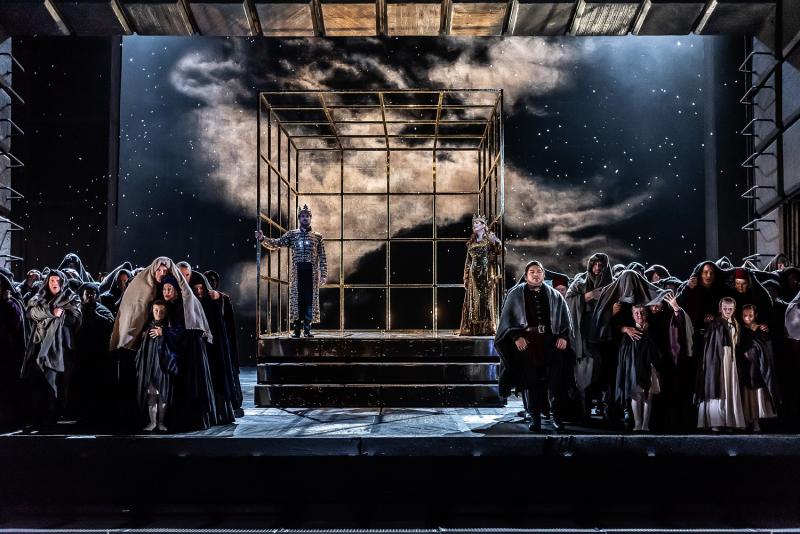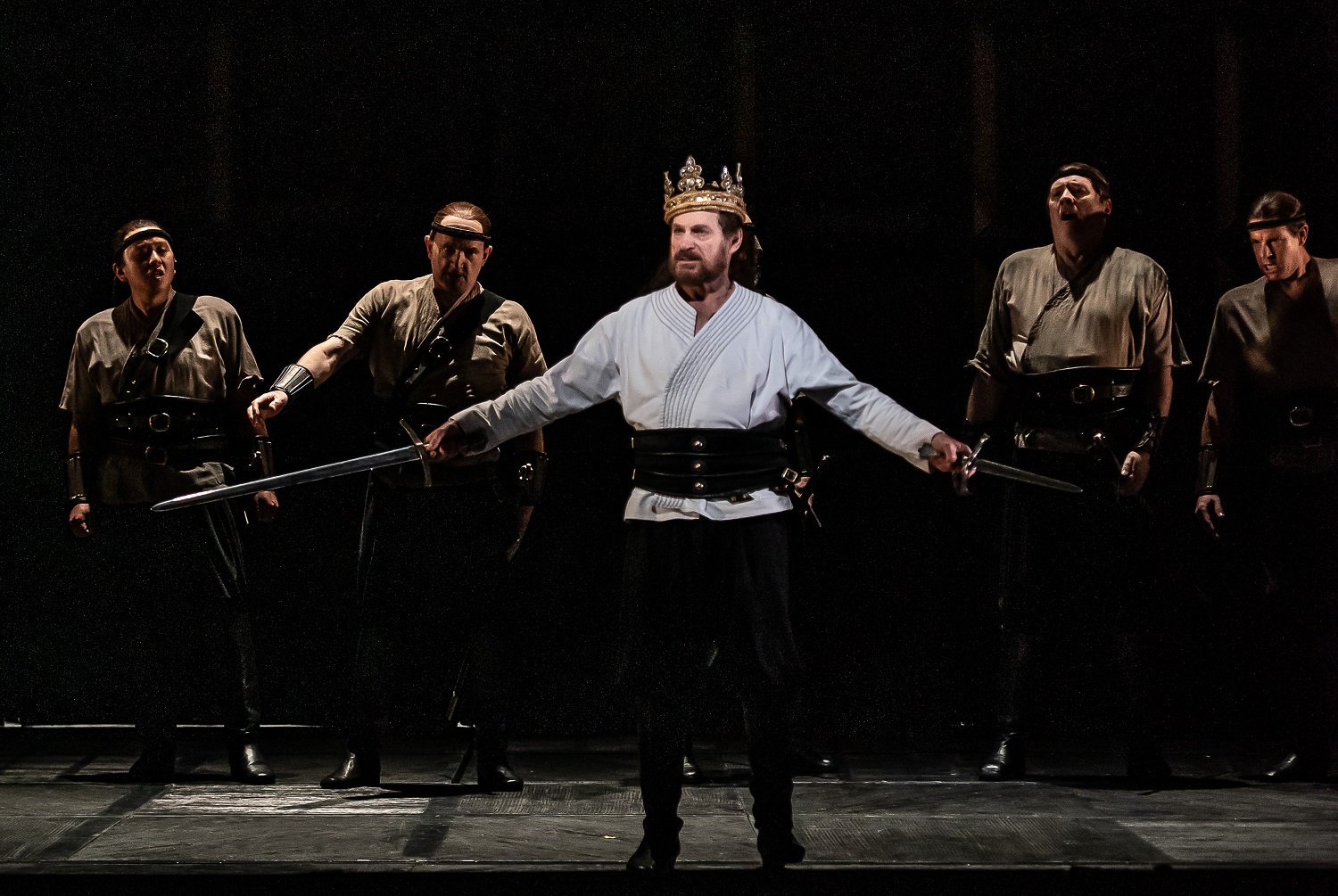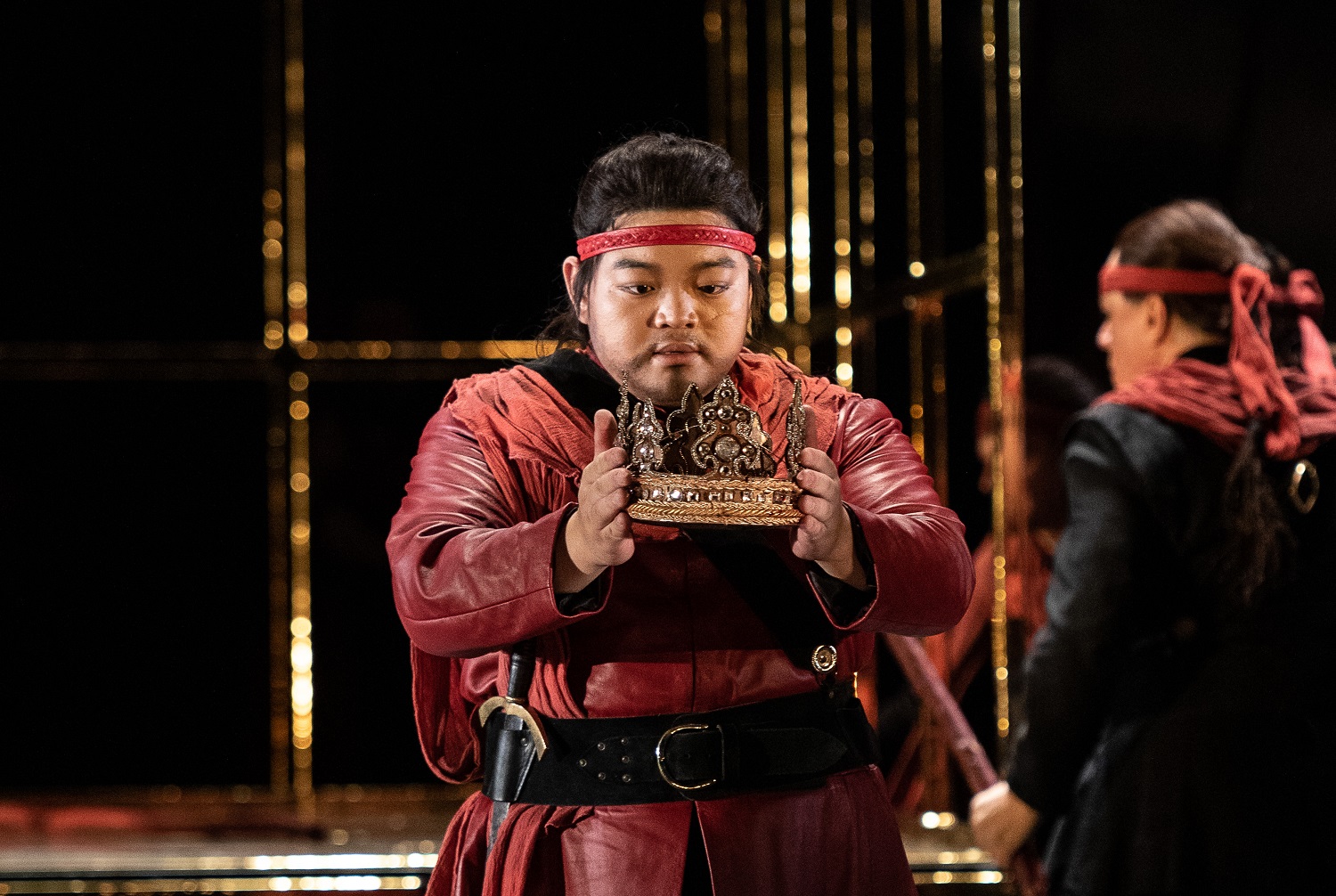Macbeth, Royal Opera review - bloody, bold, and resolute | reviews, news & interviews
Macbeth, Royal Opera review - bloody, bold, and resolute
Macbeth, Royal Opera review - bloody, bold, and resolute
A strong ensemble for Verdi’s tragedy, but Simon Keenlyside dominates

Phyllida Lloyd’s production of Macbeth has been in rep at the Royal Opera since 2002, and it is a solid performer. The setting is slick and vaguely period, with lots of iron weaponry, smart, pony-tailed warriors, but not a kilt in sight.
 The other big idea here is the witches. Verdi expands Shakespeare’s three witches to a whole choir. Lloyd extends that idea further by having the witches behind the scenes at all times, delivering letters, moving scenery, even concealing Banquo’s son at the crucial moment. Visually, they are stunning, black clad with thick eyebrows and crimson turbans. That makes for an imposing opening scene. There is no cauldron, no props at all, as the stage is completely filled with witches. Conductor Daniele Rustioni gets things off to a brisk start, with a propulsive but cleanly defined overture. But he pushes the chorus too hard in this opening scene, and the result is messy. Fortunately, Rustioni turns out to be a more sympathetic ensemble conductor than this first scene suggests, and he gets better results from the chorus later on.
The other big idea here is the witches. Verdi expands Shakespeare’s three witches to a whole choir. Lloyd extends that idea further by having the witches behind the scenes at all times, delivering letters, moving scenery, even concealing Banquo’s son at the crucial moment. Visually, they are stunning, black clad with thick eyebrows and crimson turbans. That makes for an imposing opening scene. There is no cauldron, no props at all, as the stage is completely filled with witches. Conductor Daniele Rustioni gets things off to a brisk start, with a propulsive but cleanly defined overture. But he pushes the chorus too hard in this opening scene, and the result is messy. Fortunately, Rustioni turns out to be a more sympathetic ensemble conductor than this first scene suggests, and he gets better results from the chorus later on.Enter Macbeth and Banquo. Simon Keenlyside (pictured above) has been associated with this production since 2012, and his return is reason enough to revive it. His voice has clearly matured. It has lost some bloom and colour, but none of the power and focus that make him ideal for the role of Macbeth. Günther Groissböck is just as good as Banquo. His voice is richer and rounder, it just sounds more Italian. His “Come dal ciel precipita” in act II was a musical highlight. What a shame he is murdered straight after, and we don’t hear him again (his later ghostly apparitions are all mute). Verdi goes to great lengths to give Lady Macbeth a dramatic entrance in act I, scene 2. It is a scene of rage, murder, vengeance – all motivated by Lady Macbeth herself. Anna Pirozzi sings the role with impressive technical assurance, especially in the higher register, but she doesn’t dominate the stage the way the part demands. Pirozzi has a clear, focussed tone, with tight, controlled vibrato. Verdi asks the impossible, of course – he wants everything – and Pirozzi has more to offer in the duet numbers later on, but she wasn’t imposing enough here. The banquet scene is a lot of fun. The Macbeths wear gold chainmail, which is suitably garish, but very noisy. The appearances and disappearances of Banquo’s ghost are all done with crowds gathering around him to conceal the sleight of hand – an old-fashioned trick, but it works.
The banquet scene is a lot of fun. The Macbeths wear gold chainmail, which is suitably garish, but very noisy. The appearances and disappearances of Banquo’s ghost are all done with crowds gathering around him to conceal the sleight of hand – an old-fashioned trick, but it works.
Visually, the second half is even more impressive. We return to the witches, a group of whom are now representing the contents of the boiling cauldron in fluid dance. The appearance of the three apparitions is again done with crowd effects, and very effectively. A musical highlight, as usual, is the refugee chorus, “Patria oppresa!” The chorus was on fine form here, and so too was the orchestra, subtly supporting the harmonies and adding a wistful veneer from the upper strings. Some impressive new voices are also added in these closing scenes. The small but demanding role of Macduff was taken by the young tenor David Junghoon Kim (pictured above). He has excellent projection, and a fine upper register. Lady Macbeth’s mad scene is framed by dialogue between her lady-in-waiting and doctor, both beautifully sung by April Koyejo-Audiger and Blaise Malaba. Pirozzi was more elegant and lyrical here, but still lacked dramatic conviction.
The final scene is another impressive spectacle, involving warring armies and witches, all set around that gilded throne cage. The chorus again come into their own, and with the deaths of every major character, it is down to those impressive comprimario to round the story off. Macbeth is an opera that can show off the strengths of a good ensemble, and orchestra, chorus and cast were all on good form – but the evening belonged to Keenlyside, whose performance elevated both the music and the drama.
- Macbeth at the Royal Opera House 19-30 November. The production will be streamed live on 26 November
- More opera reviews on theartsdesk
rating
Explore topics
Share this article
The future of Arts Journalism
You can stop theartsdesk.com closing!
We urgently need financing to survive. Our fundraising drive has thus far raised £49,000 but we need to reach £100,000 or we will be forced to close. Please contribute here: https://gofund.me/c3f6033d
And if you can forward this information to anyone who might assist, we’d be grateful.

Subscribe to theartsdesk.com
Thank you for continuing to read our work on theartsdesk.com. For unlimited access to every article in its entirety, including our archive of more than 15,000 pieces, we're asking for £5 per month or £40 per year. We feel it's a very good deal, and hope you do too.
To take a subscription now simply click here.
And if you're looking for that extra gift for a friend or family member, why not treat them to a theartsdesk.com gift subscription?
more Opera
 Albert Herring, English National Opera review - a great comedy with depths fully realised
Britten’s delight was never made for the Coliseum, but it works on its first outing there
Albert Herring, English National Opera review - a great comedy with depths fully realised
Britten’s delight was never made for the Coliseum, but it works on its first outing there
 Carmen, English National Opera review - not quite dangerous
Hopes for Niamh O’Sullivan only partly fulfilled, though much good singing throughout
Carmen, English National Opera review - not quite dangerous
Hopes for Niamh O’Sullivan only partly fulfilled, though much good singing throughout
 Giustino, Linbury Theatre review - a stylish account of a slight opera
Gods, mortals and monsters do battle in Handel's charming drama
Giustino, Linbury Theatre review - a stylish account of a slight opera
Gods, mortals and monsters do battle in Handel's charming drama
 Susanna, Opera North review - hybrid staging of a Handel oratorio
Dance and signing complement outstanding singing in a story of virtue rewarded
Susanna, Opera North review - hybrid staging of a Handel oratorio
Dance and signing complement outstanding singing in a story of virtue rewarded
 Ariodante, Opéra Garnier, Paris review - a blast of Baroque beauty
A near-perfect night at the opera
Ariodante, Opéra Garnier, Paris review - a blast of Baroque beauty
A near-perfect night at the opera
 Cinderella/La Cenerentola, English National Opera review - the truth behind the tinsel
Appealing performances cut through hyperactive stagecraft
Cinderella/La Cenerentola, English National Opera review - the truth behind the tinsel
Appealing performances cut through hyperactive stagecraft
 Tosca, Royal Opera review - Ailyn Pérez steps in as the most vivid of divas
Jakub Hrůša’s multicoloured Puccini last night found a soprano to match
Tosca, Royal Opera review - Ailyn Pérez steps in as the most vivid of divas
Jakub Hrůša’s multicoloured Puccini last night found a soprano to match
 Tosca, Welsh National Opera review - a great company reduced to brilliance
The old warhorse made special by the basics
Tosca, Welsh National Opera review - a great company reduced to brilliance
The old warhorse made special by the basics
 BBC Proms: The Marriage of Figaro, Glyndebourne Festival review - merriment and menace
Strong Proms transfer for a robust and affecting show
BBC Proms: The Marriage of Figaro, Glyndebourne Festival review - merriment and menace
Strong Proms transfer for a robust and affecting show
 BBC Proms: Suor Angelica, LSO, Pappano review - earthly passion, heavenly grief
A Sister to remember blesses Puccini's convent tragedy
BBC Proms: Suor Angelica, LSO, Pappano review - earthly passion, heavenly grief
A Sister to remember blesses Puccini's convent tragedy
 Orpheus and Eurydice, Opera Queensland/SCO, Edinburgh International Festival 2025 review - dazzling, but distracting
Eye-popping acrobatics don’t always assist in Gluck’s quest for operatic truth
Orpheus and Eurydice, Opera Queensland/SCO, Edinburgh International Festival 2025 review - dazzling, but distracting
Eye-popping acrobatics don’t always assist in Gluck’s quest for operatic truth
 MARS, Irish National Opera review - silly space oddity with fun stretches
Cast, orchestra and production give Jennifer Walshe’s bold collage their all
MARS, Irish National Opera review - silly space oddity with fun stretches
Cast, orchestra and production give Jennifer Walshe’s bold collage their all

Add comment